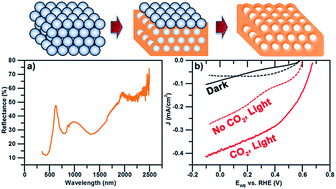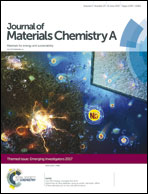Fabrication and optical characterization of polystyrene opal templates for the synthesis of scalable, nanoporous (photo)electrocatalytic materials by electrodeposition†
Abstract
Finding solutions to improve the performance of semiconductor light absorbers and catalyst materials remains an outstanding issue that prevents the realization of solar fuel generators. Nanostructuring approaches of photoelectrocatalytic materials have the potential to reduce bulk recombination and improve electron–hole pair separation in semiconductor light absorbers, as well as to increase the active surface area and influence the activity in catalytic systems. Herein, we propose a versatile approach for the synthesis of reproducible, highly homogeneous, large scale nanoporous (photo)electrocatalytic materials for artificial photosynthesis. By identifying and carefully analyzing critical parameters for forming opal templates from solutions of colloidal polystyrene beads (PS), we are able to reproducibly fabricate large area (>cm2) PS films with high optical quality over a wide diameter range (170–600 nm). Using these PS bead opal films as templates, we demonstrate that electrodeposition is a suitable bottom-up infilling technique to produce scalable, homogeneous, and highly ordered nanoporous (photo)electrocatalytic materials, namely Cu2O, BiVO4, CuBi2O4, and Cu. We provide morphological, structural, and optical characterization of the resulting opal replicas. Finally, we demonstrate preliminary integration of the Cu2O inverse opal film into a working photocathode under CO2 reduction conditions.

- This article is part of the themed collections: Celebrating Excellence in Research: Women of Materials Science and Journal of Materials Chemistry A Emerging Investigators


 Please wait while we load your content...
Please wait while we load your content...